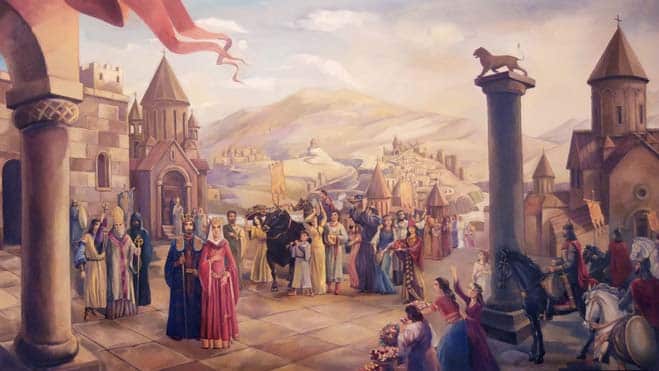Armenia divided between the Persian and Byzantine Empires
After adopting Christianity as an Official State Religion and after the fall of the ruling Arsacid dynasty, Armenia was in a struggle to defend its religion. Between 430-634, the Armenian Kingdom was divided between two greater forces.
The Kingdom turned into small independent states that were ruled by Armenian noblemen. These Noble families had their own lands and fortresses high up the mountains.
Some were allies to The Byzantine Empire and others to the Persian Empire, who used their allegiances to weaken the Armenian Kingdom. The Persians were trying to convert Armenia to the Zoroastrian religion, while Byzantines were indifferent.
The Battle of Avarayr
- In 449, Sasanian Emperor Hazkerd II orders Armenians to renounce their Christianity.
- The Armenian Religious leaders and Archbishops gather in Ashdishat in 450, confirming their faith.
- In the Spring of 451, 200 thousand soldiers of the Persian Army enter Armenia.
- On May 26, 451, Avarayr Battle takes place
- Vartan Mamikonian falls on the battlefield with 1036 friends, including 8 Generals
The spiritual independence of Armenia
In 325, The Armenian Church participated in The First Council of Nicaea and adopted the Nicene Creed, which is still recited in the Armenian Church (Havadamk).
In 451, busy with the wars, The Armenian Church was not able to attend the Council of Chalcedon. They refused the Dyophysite (two natures) formula.
This separated The Armenian Church from the Roman and Byzantine Churches.
The Arab invasions
The Arab invasions of Armenia were answered viciously by an excellent resistance 639-654, led by prince Theodore Rshtuni, a Byzantine ally. Armenia was virtually independent.
After conquering Persia, the Arabs started to concentrate their armies against Armenia but didn’t manage to defeat the country until 654.
After successfully seizing Iran, they were able to take Armenia as well. The Armenians accepted Arab rule with the precondition of freedom of faith with the Persians. They assigned Armenian rulers to the self-governed areas.
Bagratunian Dynasty, Third Armenian Kingdom
During the second half of the 9th Century, Armenian History changed significantly. The Political Genius of one of the best Noble Houses of Armenia gained power during the first decades of the 9th century.
The House of Bagratunis, one of the ancient Armenian Dynasties, was in charge of the Cavalry during the rule of the Arsacid dynasty. They were able to resurrect an Independent Armenia after 400 years of absence.
Bagratunis helped the Arabs against revolutions and gained power and more lands. The Arabs successfully weakened the rest of the Armenian Noble houses, which helped Bakradunis regain and rule most of the Armenian lands.
In 885, the Arab Calipha and Byzantine Ceasar Vasil I sent crowns to the First Bagratuni king Ashot I, recognizing the Armenian Kingdom. The Armenian Kingdom, and the Byzantine, still paid taxes to Arabs.
After recognizing the Kingdom Taxes were reduced from 10 Million Dirham (around 2 Million US Dollars) to 1 Million Dirham (200000 US Dolars). (Source: Die inneren Zustaende von Armenien unter Ashot I, Berlin 1904)

End of the Bagratunis in the 10th century by the Byzantine Empire.
The Byzantine Empire weakened the Armenian Kingdom by supporting the other independant Armenian states against the Bagratunis.
Although they were able to defeat individual Azeri and Seljuk and Byzantine atacks, they eventually were defeated by the Byzantine- Turkic coallition.
The defeat of Armenia was the start of the turkic invasion to Europe.
Source: The Treachery and fall of City of Ani (A. Rambaud, L’Empire grec au Xe siecle, Paris, 1870, p.519)
Bagratuni Relation with Jews?
According to the Armenian historian Movses Khorenatsi, the Bagratunis have a Jewish origin by Spambot, one of the Jewish captives brought to Armenia by King Hayk. The same version can be found in another medieval historian, Moses Kagankatvatsi.
Robert Thomson of the University of Oxford notes that medieval Armenian historians drew parallels between the history of the Armenians and the Jews, and some of them tried to find a physical connection between the two peoples through fictitious genealogies.
According to Nikolay Adonts, this dynasty originated on the border with Armenia or Atropateno on the outskirts of Armenia.
Bagratuni vs Bagratid vs Bagrationi
According to ENCYCLOPÆDIA IRANICA, “BAGRATIDS, possibly the most important princely dynasty of Caucasia (Bagratuni in Armenia, Bagrationi in Georgia)”

